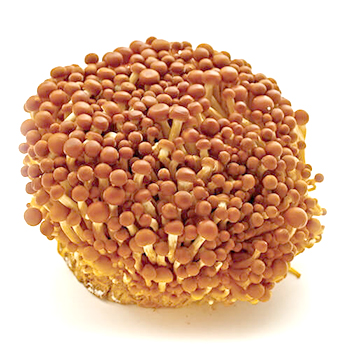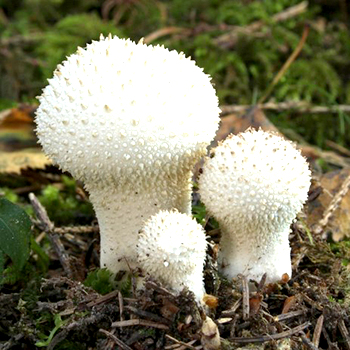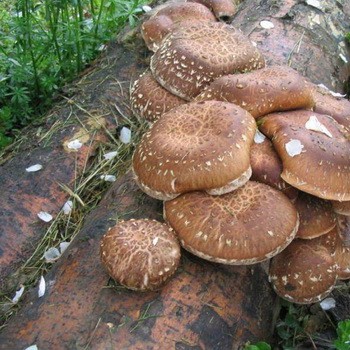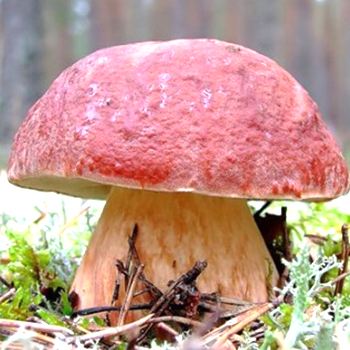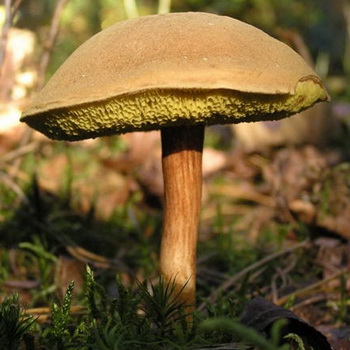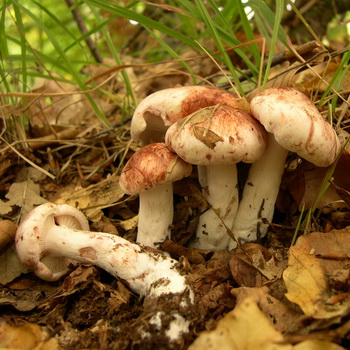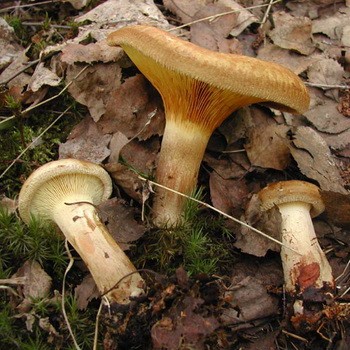Mushroom ringworm: description and cultivation

Content
Photo and description of the ring
Currently, two varieties of edible annulus are cultivated. These are massive agaric mushrooms. Varieties of the ring differ in mass. Larger Gartenriese, smaller - Winnetou.
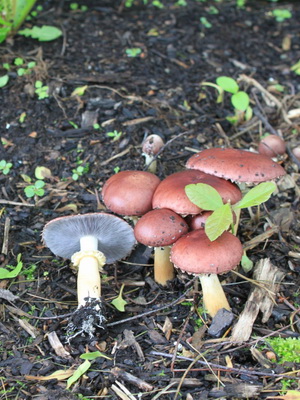
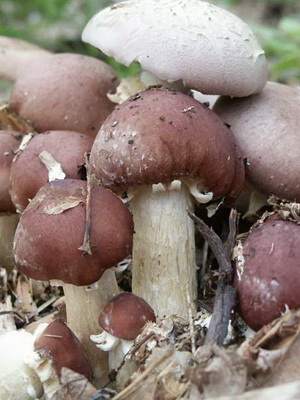
Ring (Stropharia rugoso-annulata) in natural conditions grows on wood chips, on soil mixed with sawdust, or on straw covered with soil. It can grow on champignon compost, but for better fruiting, compost should be mixed with sawdust, straw or wood chips in a ratio of 1: 1.
The fruiting bodies are large, with a hat diameter of 50 to 300 mm and a mass of 50 to 200 g. At the time of its appearance from the forest litter or from the garden beds, the ring with an almost round brown hat and a thick white leg resembles porcini. However, unlike porcini mushroom, the annulus belongs to lamellar mushrooms. Subsequently, the hat acquires a lighter, brick color, its edges are bent down. The plates are first white, then light purple and finally bright purple.
As you can see in the photo, the ring has a thick, even leg, thickening to the base:
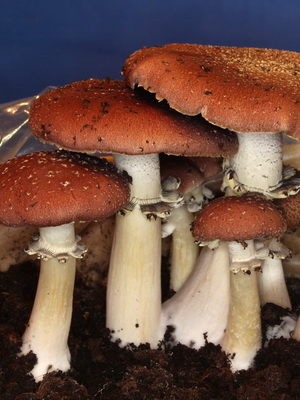
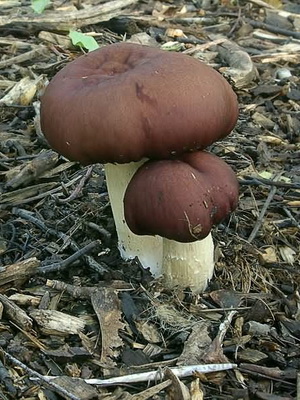
The edge of the cap is curved and has a thick membrane cover that breaks when the mushroom ripens and remains in the form of a ring on the stem. The remains of the bedspread often remain on the hat in the form of small scales.
So, you got acquainted with the description of the ringworm mushroom, and what does it taste like? This mushroom is very fragrant. Especially good are the round hats of the young ring-collector, collected immediately after their appearance from the garden. In the morning, slightly moistened and quite dense, they really look like a hat of a small porcini mushroom or boletus. The taste also resembles noble mushrooms, but there are also features. The taste of boiled mushroom caps, but has a slight aftertaste of boiled potatoes. However, they are very suitable for snacks, as well as for soups. For harvesting for the winter, young mushrooms, ringworms can be frozen or dried. Round hats do not stick together when frozen, they can be stored in bulk when frozen, they do not crumble. Before drying, it is better to cut the hat into 2-4 plates, then they look prettier in the soup.
It is recommended not to bring the growing fungi to the phase of biological maturity, when the hats become flat and the plates are purple. Overgrown rings are less tasty. But if you do not have time to collect the mushrooms on time, then use them fried with onions and potatoes.
The technology of growing a ring on the beds
The plot for growing ringworm mushrooms should be adequately illuminated in spring and autumn, and in summer, on the contrary, should be protected from direct sunlight.You can plant mushrooms together with pumpkins, which with their leaves create a favorable microclimate: provide humidity and the necessary shading.
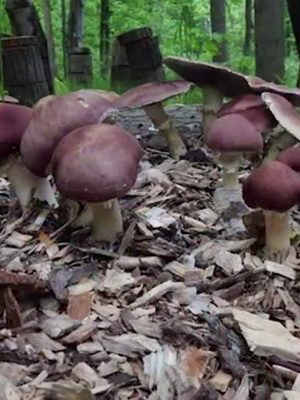
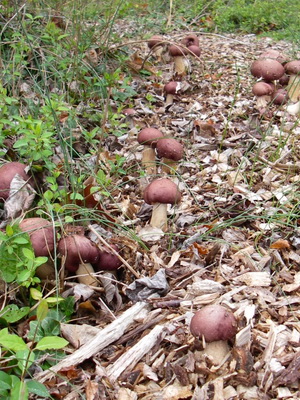
Excellent results are obtained on fresh wood chips from deciduous trees. Fresh wood chips have enough moisture and do not require any additional processing. Softwood and oak chips, pine and spruce needles can only be used as an additive (no more than 50% of the total weight). Chips from the branches are rammed in the form of beds 30-40 cm thick, 140 cm wide and watered. If the chips are dry, the bed is watered for several days in the morning and in the evening. Substrate mycelium is added to the chips at the rate of 1 kg per 1 m2 of beds. The mycelium is dripped to a depth of 5 cm in portions the size of a walnut. Sometimes a well-overgrown substrate is used as mycelium. A layer of ordinary garden soil (cover soil) is poured over the beds. In dry time, the integumentary soil is moistened daily.
When growing a ring, wheat straw can be used as a substrate. It is soaked for a day in a container under the press. Then they are placed in shaded places in the form of low ridges with a thickness of 20-30 cm and a width of 100-140 cm. 25-30 kg of dry straw is required per 1 m2 of ridges. Then, substrate mycelium is also introduced into the straw at the rate of 1 kg / m2.
In warm time (May - June), overgrowth of the substrate and the appearance of long cords (rhizomorph) occur in 2-3 weeks.
After 8-9 weeks, colonies of the mycelium of the annulus become visible on the surface, and after 12 weeks a continuous layer forms from the substrate intertwined with the mycelium. After lowering the night air temperatures, abundant fruiting begins. The ring is considered a summer mushroom. The ideal temperature in the middle of the beds is 20-25 ° C. Ringworm mycelium develops rapidly and in a few weeks rhizomorphs form, which contribute to the development of the entire substrate. Complete colonization of the substrate takes 4-6 weeks. The embryos of fruiting bodies form after 2-4 weeks on straw and after 4-8 weeks on wood chips.
Fruit bodies appear in groups. Mushrooms form in the contact zone of straw and soil. Rhizomorphs of the ringworm, when grown on a bed, can reach far beyond it (by tens of meters) and form fruiting bodies there. However, fruiting waves are not as uniform as in champignon. Usually 3-4 waves are collected. Each new wave appears 2 weeks after the previous one. Mushrooms are picked with an unbroken or recently torn bedspread. This extends the shelf life of mushrooms. Watering the beds is necessary to obtain high-quality mushrooms. The fruit bodies of the annulus are quite fragile and do not tolerate shifting from one container to another. On wood chips with integumentary soil, the yield reaches 15% of the substrate mass, on straw, the yield is less.
Substrate mycelium for growing rings
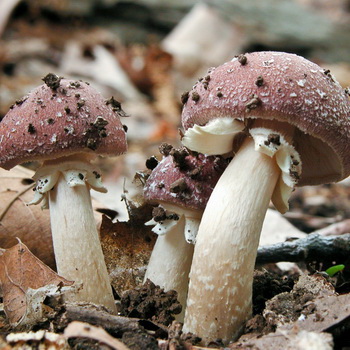 Until the middle of the last century, substrate mycelium was used for vegetative propagation of fungi. In mushroom growing, the process of vegetative "sowing" of mushrooms using mycelium is called inoculation. So, champignon compost was inoculated with slices of compost already mastered mushroom champignon. Such a composted "seed" mycelium is one example of substrate mycelium. Compost mycelium was used not only for the cultivation of champignons, but also other humus, and sometimes litter fungi. So "sowed" all kinds of champignons, mushrooms, umbrellas and even a ring.
Until the middle of the last century, substrate mycelium was used for vegetative propagation of fungi. In mushroom growing, the process of vegetative "sowing" of mushrooms using mycelium is called inoculation. So, champignon compost was inoculated with slices of compost already mastered mushroom champignon. Such a composted "seed" mycelium is one example of substrate mycelium. Compost mycelium was used not only for the cultivation of champignons, but also other humus, and sometimes litter fungi. So "sowed" all kinds of champignons, mushrooms, umbrellas and even a ring.
To propagate summer mushrooms, oyster mushrooms and other tree mushrooms, substrate mycelium was used on the basis of sawdust developed with the right mycelium (sawdust mycelium). For the cultivation of mushrooms on stumps and on pieces of wood, wooden cylindrical dowels infected with a tree fungus were on sale. Such dowels can also be called substrate mycelium. Abroad, they are produced now.
The substrate mycelium contains almost no excess nutrition for mushrooms - only mycelium for their vegetative propagation. Therefore, it can be stored for a long time without loss of quality and it can be introduced into a non-sterile substrate.
As the cultivation technology of mushrooms improved, firms producing mycelium switched to grain as a carrier of mycelium. Mycelium made on wheat, barley or millet is called grain. Cereal mycelium released only on sterilized grain. Therefore, with the use of grain mycelium, it is possible to establish a sterile technology for the production of mushrooms, which ensures maximum yield on a sterilized substrate. But in real production, pasteurized substrate is sown with cereal mycelium. The advantage of grain mycelium over substrate mycelium is its economical consumption and ease of use. With sterile technology, you can introduce a few grains of millet with mycelium of the mushroom into a kilogram bag with a substrate and the mushrooms will grow and give a decent harvest. Actually, grain mycelium is added to the substrate from 1 to 5% by weight of the finished substrate. This increases the nutritional value of the substrate due to the grain of the mycelium and allows faster growth of the substrate.
But how to use grain mycelium for “sowing” a mushroom, such as a ring, in a non-sterile bed? As it turned out, it is not as simple as it seems. With this sowing, molds are poured onto sterile mycelium grain, the grain is instantly covered with green mold spores, and the ringworm mycelium dies. To get a good result, you must first “sow” sterile grain mycelium in a bag with a sterile substrate of wood chips, wait until the ringwort has developed there, and only then use it as a substrate mycelium for planting beds.
Ring Shredder
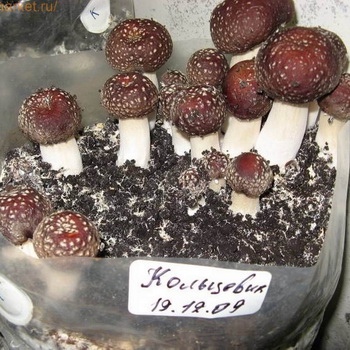 A large crop of tree mushrooms can be obtained only on beds or on a loose substrate in plastic bags, but not on pieces of wood. The substrate must be moist, nutritious and loose so that it has enough oxygen necessary for the growth of mushrooms. All these requirements are met by a substrate of freshly ground branches.
A large crop of tree mushrooms can be obtained only on beds or on a loose substrate in plastic bags, but not on pieces of wood. The substrate must be moist, nutritious and loose so that it has enough oxygen necessary for the growth of mushrooms. All these requirements are met by a substrate of freshly ground branches.
Chips can replace straw during the cultivation of oyster mushrooms, shiitake and other tree fungi. But the main thing for which you need to buy a chopper is to make a substrate for beds with a ring. Freshly milled branches with leaves, and preferably without leaves, are a ready-made substrate with a humidity of about 50%, which does not need to be moistened beforehand. The branches of trees and shrubs contain enough nutrients necessary for the development of fungal mycelium.
Need any garden chopper with knives. At the same time as the chopper, I recommend buying spare replacement knives. They only need to process fresh branches. Then we get chips of the right size, and the chopper itself will last a long time. Gear models can also be used, but they produce an insufficiently permeable substrate for air. Young birch trees with a thickness of up to 4 cm are well grinded in a garden shredder. Near birch coppices in abandoned fields, self-seeding areas are formed with a dense forest of young birch trees. Such self-seeding does not occur in the forest, but on agricultural land, where it spoils the fields. Moreover, if not all birches are cut in a row, but self-seeding is thinned out, this will improve the growth of birch bark and porcini mushrooms in it.
In fragile, or white, willow growing along roads and rivers, branches in one season can grow up to 5 cm thick! And even they grind well. If you root several dozen such willows in the estate, then after 5 years you will have an inexhaustible source of substrate for mushrooms. All deciduous trees and shrubs, forming long and straight branches are suitable: willow of a bredin, hazel, aspen, etc. Chips from oak branches are suitable for growing shiitake, but not ringworm and oyster mushrooms, because their enzymes do not decompose tannins.
The branches of pines and firs are also well milled, but they are very sticky with the resin knives of the chopper and its inner body. Chips from coniferous branches are suitable only for growing row of purple (Lepista nuda).
Dry branches of trees and shrubs are not suitable for shredding, as they are often affected by mold. And, in addition, when grinding dry, especially soil contaminated branches, knives quickly blunt.
If you need to store the substrate for future use, then for storage it must be dried under a canopy, and moisten before use. To get a substrate with a humidity of 50%, the dried wood chips must be filled with water for 30 minutes, then drained and dried, the resulting wood chips on the bed during the day.
Watering a plantation with a ring
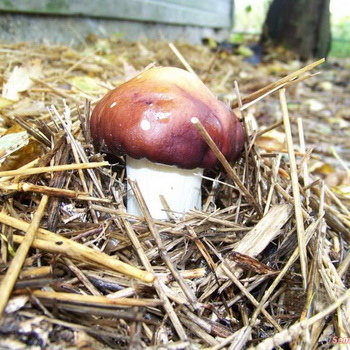 For good fruiting of the mushroom plantation, regular watering is needed. Organizing it is not difficult at all.
For good fruiting of the mushroom plantation, regular watering is needed. Organizing it is not difficult at all.
There is a small spring in the garden, so there was no need to make a well or a well. Water from the spring flows down the site in the form of a small stream and collects in a pond 4 x 10 m in size. An asbestos-cement pipe 8 m long is laid from there, from which water flows into a sump, where clay particles settle. Then clean trickles of water replenish the concrete tank with a diameter of 2.5 m and a depth of 2 m, where a drainage pump with a capacity of 1100 W is installed, providing a pressure of 0.6 atm with a capacity of 10 m3 / h. For additional purification of water from clay particles, the pump is placed in a plastic can, on which a 200 micron thick bag of agri is put on. Agril is a cheap covering material for garden beds.
The pump delivers water to a pipe with a diameter of 32 mm. Then, using special fittings, water is distributed through pipes with a diameter of 20 mm. It is recommended to use pipes and fittings made of low pressure polyethylene (HDPE) - it is a reliable and cheapest system of pipes and fittings.
Irrigation pipes were carried out at a height of 2.2 m above the ground using vertical posts made of reinforcement with a diameter of 12 mm. This allows you to mow the lawn and care for the mushroom plantation without interference. Water spraying occurs from upwardly directed watering cans. Watering cans are plastic sprayers for bottles with 0.05 mm holes. They were sold in construction stores for 15 rubles. a piece. To pair them with PND fittings, 1/2 of the internal thread must be cut into them. Inside each watering can, a piece of synthetic winterizer is placed, which additionally purifies the water.
Turning on the pump produces a household timer. For irrigation of the entire mushroom plantation (15 acres) 2 times a day for 20 minutes, approximately 4 m3 of water is consumed when water from the spring arrives from 8 m3 / day to 16 m3 / day (depending on the time of year). Thus, there is still water for other needs. Some watering cans sometimes become clogged with clay, despite the sludge and filtration system. To clean them, a special water drain was made near the pump to a pipe section with 5-wire fittings. In the absence of water flow, the pump develops a pressure of more than 1 atm. This is enough to clean the watering cans by screwing them onto a pipe section and shutting off the tap to supply water to the irrigation system. Simultaneously with watering the entire mushroom plantation, compost heaps, raspberries, cherries and apple trees are watered.
Five watering cans spray water over a plantation with a ring. The total size of the beds is 3 x 10 m. Irrigation water falls on some of its beds, others remain without watering. As my experience shows, the annulus prefers to bear fruit in those areas where irrigation water does not directly fall. An analysis of the moisture content of the substrate in the fruit bed has shown that it is not necessary to water the entire surface of the bed. The mycelium of the annulus distributes moisture from irrigation in some parts of the garden over the entire surface. This proves the undoubted benefit of the presence of mycelium in the garden.
